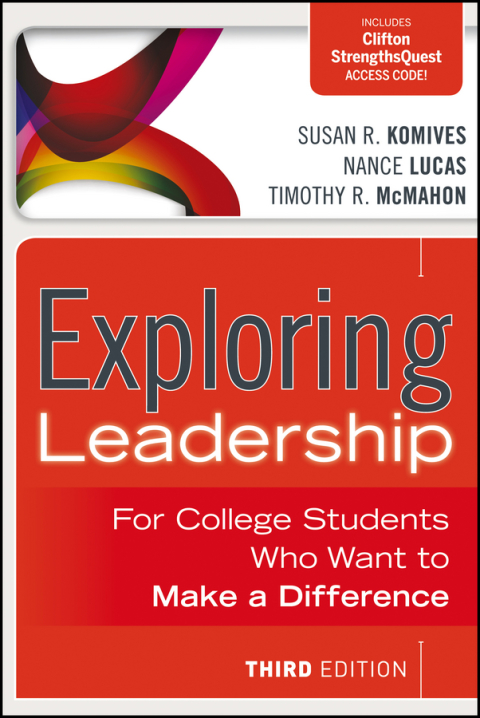Description
Efnisyfirlit
- Cover
- Important Information About Clifton StrengthsFinder
- Title Page
- Copyright
- Preface
- Purpose of This Book
- Scope of the Book and Treatment of Topics
- Summary of the Contents
- Leadership Can Be Learned
- Acknowledgments
- The Authors
- Part I : Leadership for a Changing World
- Chapter 1: An Introduction to Leadership
- Book Overview
- Chapter Overview
- Foundational Principles
- Rapidly Changing Times
- Understanding Paradigms
- Examining the Paradigms
- The Search for a New Conceptualization of Followers
- A Word About Leaders
- Purposes of Leadership
- Leadership Viewed from Different Frames
- Leadership Requires Openness to Learning
- Relational Leadership
- The Real World
- Chapter Summary
- About This Book
- What’s Next?
- Chapter Activities
- Chapter 2: The Changing Nature of Leadership
- Chapter Overview
- The Complexities of Leadership
- Myths About Leadership
- Truths About Leadership
- Definitions of Leadership
- Metaphorical Definitions of Leadership
- Generations of Leadership Theories
- Influence Theories
- Reciprocal Leadership Theories
- Leadership Maps for a Rapidly Changing World
- Relationships, Connections, and “Anding”
- Authentic Leadership
- Chapter Summary
- What’s Next?
- Chapter Activities
- Chapter 3: The Relational Leadership Model
- Chapter Overview
- Relational Leadership
- Knowing-Being-Doing
- Relational Leadership Is Purposeful
- Working for Positive Change
- Relational Leadership Is Inclusive
- Involving Those External to the Group
- Relational Leadership Is Empowering
- Relational Leadership Is Ethical
- Relational Leadership Is About Process
- What Would This Look Like?
- Chapter Summary
- What’s Next?
- Chapter Activities
- Part II : Exploring Your Potential for Leadership
- Chapter 4: Understanding Yourself
- Chapter Overview
- Understanding Yourself
- Self-Leadership Development
- Esteem and Confidence
- Finding Your Ideal Self Through Mindfulness
- Emotional Intelligence
- Developing Your Talents and Strengths
- Factors That Shape Your Leadership Identity
- Values, Beliefs, Ethics, and Character
- Chapter Summary
- What’s Next?
- Chapter Activities
- Chapter 5: Understanding Others
- Chapter Overview
- Individuality and Commonality
- Understanding Gender Diversity
- Understanding Cultural Diversity
- Understanding International Diversity
- Your Cultural Heritage
- Attitudes Toward Differences
- Microaggressions
- Communication
- Conflict Resolution and Decision Making
- Leadership and Communication
- Assertive Communication
- Difficult Dialogues
- Relational Empathy
- Cultural Influences on Leadership Behavior
- Chapter Summary
- What’s Next?
- Chapter Activities
- Chapter 6: Leading with Integrity
- Chapter Overview
- Creating and Sustaining an Ethical Organizational Environment
- Moral Purpose as an Act of Courage
- Assumptions about Ethical Leadership
- Cultural Assumptions
- Ethical Theories and Moral Purposes
- Transforming Leadership Theory
- Modeling a Moral Purpose
- Moral Talk
- Ethical Decision-Making Models
- Practical Applications
- Kidder’s Ethical Decision Making Model
- Ethical Principles and Standards
- Chapter Summary
- What’s Next?
- Chapter Activities
- Part III : Context for the Practice of Leadership
- Chapter 7: Being in Communities
- Chapter Overview
- The Importance of Community
- Elements of Community
- The Development of Community
- Chapter Summary
- What’s Next?
- Chapter Activities
- Chapter 8: Interacting in Teams and Groups
- Chapter Overview
- Understanding Groups
- Group Development
- Dynamics in Groups
- Chapter Summary
- What’s Next?
- Chapter Activities
- Chapter 9: Understanding and Renewing Complex Organizations
- Chapter Overview
- Groups and Organizations
- Organizations as Complex Systems
- Virtuality and the Impact of Technology
- New Paradigm Leadership in Conventional Paradigm Cultures
- Organizational Renewal
- When Things Go Wrong
- Chapter Summary
- What’s Next?
- Chapter Activities
- Part IV : Making a Difference with Leadership
- Chapter 10: Understanding Change
- Chapter Overview
- Understanding Change
- Facilitating Change
- Social Entrepreneurship and Social Innovation
- What’s Next?
- Chapter Activities
- Chapter 11: Strategies for Change
- Chapter Overview
- Reflections on Change
- Students as Change Leaders
- The Social Change Model of Leadership Development
- Comparison of the Relational Leadership Model and Social Change Model
- Building Coalitions for Community Action
- Civic Engagement
- Service as Change-Making
- Identifying Critical Issues
- Joining with Others
- Conflict
- Navigating Environments
- Appreciative Inquiry
- Change and Cyberspace
- Conclusion
- What’s Next?
- Chapter Activities
- Chapter 12: Thriving Together
- Intersection of Leadership and Positive Psychology
- Positivity and the Tipping Point
- Positive Leadership
- PERMA Model of Well-Being
- The Cycle of Renewal in Leadership Development
- Resonant Leaders and Renewal
- Spirituality and Renewal
- Chapter Summary
- Chapter Activities
- A Final Reflection
- References
- Author Index
- Subject Index
- End User License Agreement






Reviews
There are no reviews yet.